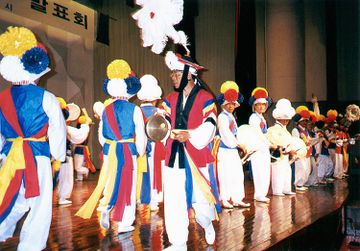광산농악
| 광산농악 Gwangsan Nongak (Farmers’ Performance of Gwangsan) |
|
 광산농악, 국가문화유산포털, 문화재청. |
|
| 대표명칭 | 광산농악 |
|---|---|
| 영문명칭 | Gwangsan Nongak (Farmers’ Performance of Gwangsan) |
| 한자 | 光山農樂 |
| 지정(등록) 종목 | 광주광역시 무형유산 |
| 지정(등록)일 | 1992년 3월 16일 |
| 분류 | 무형문화재 |
| 웹사이트 | 광산농악, 국가문화유산포털, 문화재청. |
해설문
국문
광산농악은 광산구 지역에 예로부터 전해지는 다양한 농악을 집대성한 전통예술이다. 농악이란 농촌에서 농부들이 공동작업을 할 때 흥을 돋우거나, 풍년을 기원하고 액운을 막기 위해 행하는 연주, 춤, 기예, 의식 등을 두루 가리킨다. 광산농악은 호남우도농악*의 하나이며, 마륵동의 판굿농악, 칠석동의 고싸움농악, 소촌동의 당산농악, 산월동의 풍장농악 등을 포함한다.
농악대는 행사의 규모에 따라 적게는 20~30명, 많게는 50~70명으로 구성되며, 크게 앞치배**와 뒤치배로 나뉜다. 앞치배에는 꽹과리, 장구, 북, 징, 소고, 나팔, 태평소 등의 연주자가 있고, 뒤치배에는 대포수, 양반, 할미, 조리중, 각시, 참봉, 남녀 무동 등이 있다.
광산농악의 특징은 가락의 변화가 많고, 가락마다 시작과 끝을 분명히 하여 새 가락으로의 전환이 자연스럽게 이루어진다는 점이다. 또한 설장고와 같은 개인 놀이와 춤사위가 발달하여 다채롭고 흥겹게 구성되어 있다는 점도 주목할 만하다. 판굿은 구성지면서도 슬픈 가락으로 되어 있으며, 광산농악에서만 유일하게 전승되고 있다.
현재 상쇠 정득채(鄭得采), 설장고 김종회(金宗會), 설북 서창순(徐昌淳)이 예능 보유자로 지정되어 있다.
- 호남우도농악: 전라남도의 서부평야지대를 중심으로 발달한 농악.
- 치배: 농악대의 구성원. 악기 연주자, 깃발을 드는 기수(旗手), 농악대의 뒤를 따르며 흥을 돋우는 잡색(雜色) 등이 있음.
영문
Gwangsan Nongak (Farmers’ Performance of Gwangsan)
Farmers’ performances, called nongak in Korean, are a popular performing art derived from communal rituals and rustic entertainment that combine a percussion ensemble and sometimes wind instruments, parading, dancing in various formations, skits, and acrobatic feats. These performances are closely tied to traditional folk religion and were held on special occasions to appease local guardian deities, ward off evil spirits, and to wish for and celebrate a prosperous harvest.
The farmers’ performance of Gwangsan consists of various performances that have been passed down for generations in Gwangju, including in Sochon-dong, Sanwol-dong, Mareuk-dong, and Chilseok-dong. It is representative of the western Jeolla-do style of farmers’ performances.
Depending on the scale of the event, the number of participants can range from 20-30 people up to 50-70 people. The performers are divided into two groups: musicians and actors. The musicians play percussion and wind instruments used in Korean folk music such as the small gong (kkwaenggwari), the large gong (jing), the double-headed drum (janggu), the barrel drum (buk), the hand drum (sogo), the bugle (napal), and the double-reeded horn (taepyeongso). The musicians followed around by the actors who depict folk characters such as an artilleryman, a nobleman, an old woman, a monk, a bride, a low-ranking official, and children. The rhythms are diverse and change frequently with clear and natural transitions. Solo instrumental performances, such as the solo double-headed drum (seoljanggu), and well-developed dancing techniques add variety and merriment to the performance.
The lead small gong player Jeong Deuk-chae, solo double-headed drum performer Kim Jong-hoe, and solo barrel drum performer Seo Chang-sun are officially designated as masters of their valuable artistic skills.
영문 해설 내용
농악은 공동체 의식과 농촌 사회의 여흥 활동에서 유래한 대중적인 공연 예술의 하나로, 타악기 합주, 관악기 연주, 행진, 춤, 연극, 기예 등이 함께 어우러진다. 이러한 농악은 전통적인 민속 신앙과 밀접하게 관련되어 있으며, 마을신을 즐겁게 하고 액운을 쫓고 풍농을 기원하고 풍년을 축하하기 위해 연행된다.
광산농악은 광주 소촌동, 산월동, 마륵동, 칠석동 지역에 예로부터 전해지는 다양한 농악들로 이루어져 있으며, 전라도 서부 지역을 대표하는 농악이다.
농악대는 행사의 규모에 따라 적게는 20~30명, 많게는 50~70명으로 구성되며, 크게 두 그룹으로 나뉜다. 앞 그룹에는 꽹과리, 장구, 북, 징, 소고, 나팔, 태평소 등의 연주자가 있고, 뒷 그룹에는 대포수, 양반, 할미, 조리중, 각시, 참봉, 남녀무동 등이 있다. 광산농악은 가락의 변화가 많고, 가락마다 시작과 끝을 분명히 하여 새 가락으로의 전환이 자연스럽게 이루어진다. 또한 설장고와 같은 개인놀이와 춤사위가 발달하여 다채롭고 흥겹게 구성되어 있다.
현재 상쇠 정득채, 설장고 김종회, 설북 서창순이 예능 보유자로 지정되어 있다.
참고자료
- 광산농악, 한국민족문화대백과사전, 한국학중앙연구원. http://encykorea.aks.ac.kr/Contents/Item/E0005150
- 광산농악, 국가문화유산포털, 문화재청. http://www.heritage.go.kr/heri/cul/culSelectDetail.do?ccbaCpno=2222400080000
- 광산농악, 한국민속대백과사전, 국립민속박물관. https://terms.naver.com/entry.naver?docId=3561873&cid=58721&categoryId=58722